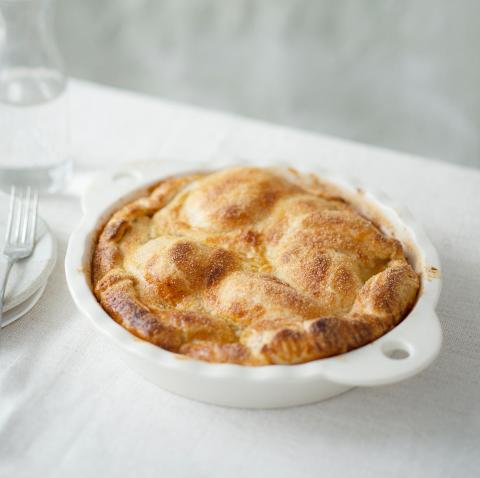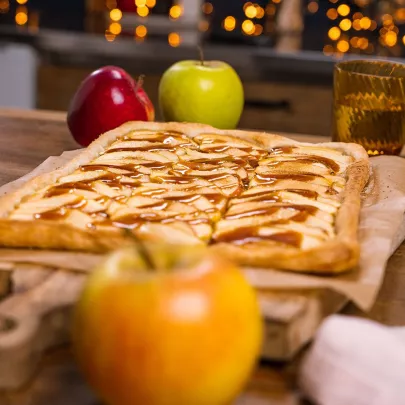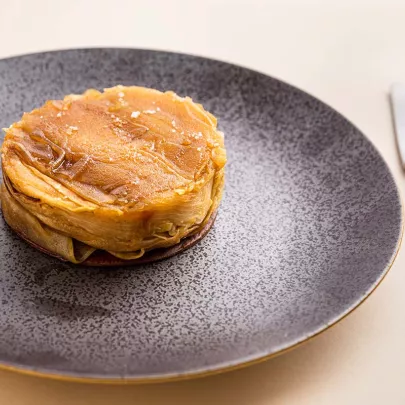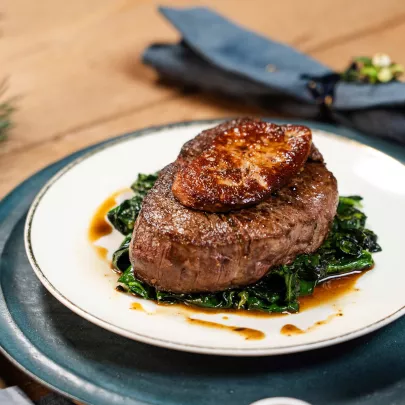
Looking for a simple, delicious dessert that brings the flavours of Gascony to your table? Armagnac and Limousin Apple Crumble is your answer. This recipe combines the rich taste of Armagnac with the tart sweetness of Limousin apples, all topped with a golden, buttery crumble. Make this famous dessert from Gascony the easy way with pre-made puff pastry!
Which Apple Varieties to Use?
Use Limousin apples for the best flavour, as they are sweet and tart and firm. If you can’t find them try other French Apples such as Honeycrisp or Granny Smith for a similar balance of sweetness and tang.
Why Armagnac?
Armagnac gives a deep smoky flavour that matches the sweetness of the apples in this crumble. If you don’t have Armagnac you can substitute with Calvados or Cognac for a different but equally delicious version.
What is Armagnac?
Armagnac is a French traditional spirit produced in the south west of France in the region of Gascony under Appellation d’Origine Contrôlée (AOC) rules. This spirit comes from the departments of Gers, Landes and Lot, areas famous for their vineyards and climate. The distillation process is done in a continuous alembic still and produces an alcohol with a robust and complex character. Unlike Cognac, Armagnac is distilled only once so the spirit is rich and full bodied. Aged in oak barrels it develops flavours of dried fruit, vanilla and spice and the natural evaporation (the angel’s share) contributes to its smoothness and balance. To be labeled as Armagnac the spirit must meet strict regulations so you can be sure of its quality and authenticity. This slow aging in oak barrels gives Armagnac its signature depth and makes it a part of French culinary heritage.
How is Armagnac made?
Armagnac production is a laborious process that starts with the harvest of the grapes from the vineyards. The grapes are fermented into wine then distilled in a single pass through a continuous alembic still. The eau de vie is then aged in oak barrels where it develops its flavours over time. The grape variety, ageing period and type of oak used all contribute to the flavour profile. The ageing process gives the spirit deep amber colours and dried fruit, prune and spice notes making Armagnac a truly artisanal product of the Gascony region.
What are the types of Armagnac?
Armagnac comes in several forms, each defined by its age and production method. VSOP is aged for at least 4 years and has a balanced flavour profile with hints of oak and fruit. Napoleon and XO are aged 6 to 10 years and are more complex. For the connoisseurs, vintage Armagnacs from a single year’s harvest have unique characteristics that reflect the region’s weather and soil. Younger ones like Blanche Armagnac are unaged and fresh, perfect for cocktails or with ice, older ones are richer and smoother.
How to drink Armagnac?
Drinking Armagnac is a sensory experience that should be savoured slowly to fully appreciate its rich and complex flavours. The best way to enjoy it is by serving it neat in a tulip-shaped glass, which concentrates its aromatic notes of dried fruit, prune, and a hint of cinnamon. Younger Armagnacs, often vibrant and fresh, can also be served over ice or used to replace other spirits, like bourbon, in cocktails. Older Armagnacs, aged in oak barrels, offer a smoother nose with intense notes of vanilla, spice, and dried fruits, making them ideal for sipping as a digestif.
Producers such as Domaine Tariquet, Pellehaut, and Château de Laubade offer a range of Armagnacs, from youthful vivant expressions to signature vintage selections. Whether you’re looking for a small bottle to try or a rare collector’s cask, these producers offer something for every taste. Pair Armagnac with dark chocolate, candied orange, or even a rich dessert like tarte Tatin for a truly indulgent experience.
If you're new to this iconic product, a guide to different types, such as Ténarèze or Bas Armagnac, will help you navigate the selection. Armagnac from Bordeaux or the heart of the Gascony region often reflects the unique terroir of their vineyards, offering a very distinct flavour profile. Whether buying for yourself or as a gift, this aromatic French spirit is a perfect choice to celebrate life’s special moments, embodying centuries of craftsmanship and tradition.
What is the history of Armagnac?
Armagnac is France’s oldest spirit, dating back to the 14th century. Initially used as a medicine, it was one of the first spirits to be made in France. Over the centuries it became very popular and was drunk all over the region. By the 17th century the Dutch started trading, exporting Armagnac down the Adour River and into international markets. It comes from the Bas Armagnac, Ténarèze and Haut Armagnac areas, which are AOC (Appellation d’Origine Contrôlée) for the terroirs.
Château de Laubade, Domaine Pellehaut and Marie Duffau are among the most famous producers to have kept the tradition alive. Larressingle, Eric Artiguelongue and Millet are still making great vintages. The Garonne River and the Pyrenees shape the region’s microclimate perfect for grape growing. Armagnac is aged in cellars where the temperature and evaporation (the “angel’s share”) will affect its development over time.
Today Armagnac is a symbol of Gascony’s rich heritage. It’s one of the most French of French products, loved for its flavours and long ageing. Whether as a digestif or a celebratory drink, it’s been part of French culture since its creation and still charms new generations of enthusiasts.
Serving Suggestions
Serve warm with a scoop of ice cream, a dollop of whipped cream or a spoonful of crème fraîche. The hot spiced apples and crunchy topping go perfectly with something cool and creamy.
Tips and Variations
Add a pinch of cinnamon or nutmeg to the apple mixture for more depth of flavour.
You can also mix some chopped walnuts, almonds or hazelnuts into the crumble topping before baking.
If you want a gluten-free version, use gluten-free puff pastry or make a crumble topping with gluten-free oats and almond flour.
Storage and Reheating
If you have leftovers, store them in an airtight container in the fridge for up to 3 days. The flavours will develop more over time so it’s even better the next day.
To reheat, place the dessert in a preheated oven at 180°C (350°F) for 10-15 minutes to restore the top. You can also reheat individual portions in the microwave for 1-2 minutes but the pastry will lose some of its crispiness.
Wine Pairing
While the recommended pairings are apple juice, Côteaux-de-l'Aubance or Clairette-de-Die, try Sauternes or Tokaji for a treat. The sweetness of these dessert wines will match the tart apples and Armagnac.
Preparation time
Ingredients For
-

-
x 2
-
70 g
-
x 1
-
10 cl
-

Preparation
1
Peel the apples. Cut them into quarters and remove the seeds. Cut the quarters into wide slices. Then move the apples to a salad bowl.
2
Add the brown sugar (minus a tablespoon), vanilla-flavored sugar, lemon juice, and Armagnac to the apples. You can use rum or Calvados instead of Armagnac. Mix it all together.
3
Roll out the puff pastry (without removing the paper) on the baking sheet.
4
Spread the apples evenly on top of the pastry. Leave a 1.5 inch border of pastry along the sides.
5
Cover the apples with the second puff pastry.
6
Carefully seal the two puff pastry crusts together. Using a knife or scissors, cut a small cross in the middle of the dessert. Sprinkle a tablespoon of sugar on top and cook for 30 minutes at 240°C (460 °F).
7
Serve warm.
Pair with
Apple juice, Côteaux-de-l'Aubance, or Clairette-de-Die.


















